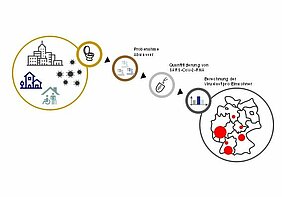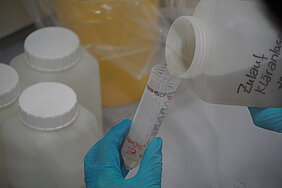SARS-CoV-2 was analysed by PCR to detect an early change in the number of COVID-19 cases and to provide more information on the incidence of infection in the population.
At the beginning of the COVID-19 pandemic, studies of COVID-19 patients showed that infected patients excreted relatively high concentrations of SARS-CoV-2 biomarkers in their faeces. Wastewater can therefore be used for integrated monitoring of the catchment area to detect changes in the incidence of infection at an early stage (early warning system), to better clarify the number of unreported COVID-19 cases at the population level and to monitor the spread of SARS-CoV-2 variants. Overall, it was hypothesised that SARS-CoV-2 biomarkers could be used to assess the overall pattern of infection in a community, including the effectiveness of control measures, as part of wastewater-based epidemiology (WBE).
The main objectives of this study were
i) to comprehensively monitor the incidence of COVID-19 infection at the population level using wastewater-based epidemiology
ii) to develop methods for the quantitative determination of SARS-CoV-2 and variants of concern (VoC) in raw wastewater
iii) to develop and test strategies for the identification of local infection hotspots in a community, and
iv) to accurately estimate and predict COVID-19 infection in a community based on PCR analysis in raw wastewater, and v) the transferability of the developed methodology to other human pathogenic viruses. A further aim was to provide recommendations for health authorities and policy makers on appropriate sampling strategies, analysis and interpretation of results based on wastewater epidemiology.
The Biomarker Project was one of the first research projects to detect SARS-CoV-2 in wastewater in Germany. This research project has produced a number of significant scientific and technical results related to wastewater monitoring. Overall, the results of the project show that wastewater monitoring for SARS-CoV-2 provides valuable data for health authorities. Detection of the virus in wastewater samples allows conclusions to be drawn about increasing and decreasing trends in the incidence of infection and the occurrence and spread of SARS-CoV-2 variants and sub-variants in the population without the need for individual testing. The results of the research project have been instrumental in bringing microbiological wastewater monitoring into routine analysis. Wastewater data are now used in conjunction with other indicators, such as syndromic surveillance, to assess the epidemiological situation.
Publications:
Holzer, C.; Ho, J.; Tiehm, A.; Stange, C.: Wastewater monitoring - passive sampling for the detection of SARS-CoV-2 and antibiotic resistance genes in wastewater. The Science of the Total Environment 959, 178244 (2025) DOI: 10.1016/j.scitotenv.2024.178244
Wilhelm, A; Schoth, J.; Meinert-Berning, C.; Bastian, D.; Blum, H.; Elsinga, G.; Graf, A.; Heijnen, L.; Ho, J.; Kluge, M.; Krebs, S.; Stange, C.; Uchaikina, A.; Dolny, R.; Wurzbacher, C.; Drewes, J.E.; Medema, G.; Tiehm, A.; Ciesek, S.; Teichgräber, B.; Wintgens, T.; Weber, F.-A.; Widera, M.: Interlaboratory comparison using inactivated SARS-CoV-2 variants as a feasible tool for quality control in COVID-19 wastewater monitoring. The Science of the total environment, 166540 (2023) DOI: 10.1016/j.scitotenv.2023.166540
Ho, J.; Stange, C.; Suhrborg, R.; Wurzbacher, C.; Drewes, J.E.; Tiehm, A.: SARS-CoV-2 wastewater surveillance in Germany: Long-term RT-digital droplet PCR monitoring, suitability of primer/probe combinations and biomarker stability. Water research 210: 117977 (2022) DOI: 10.1016/j.watres.2021.117977 (PDF-Datei)
Mitranescu, A.; Uchaikina, A.; Kau, A.-S.; Stange, C.; Ho, J.; Tiehm, A.; Wurzbacher, C.; Drewes, J.E.: Wastewater-Based Epidemiology for SARS-CoV-2 Biomarkers: Evaluation of Normalization Methods in Small and Large Communities in Southern Germany. Environmental Science & Technology, ACS EST Water, 2, 12: 2460–2470 (2022) DOI: 10.1021/acsestwater.2c00306
Rossmann, K.; Clasen, R.; Münch, M.; Wurzbacher, C.; Tiehm, A.; Drewes, J.E.: SARS-CoV-2-Krisenmanagement mithilfe eines Abwasserfrühwarnsystems am Beispiel Berchtesgadener Land. Deutsches Ärzteblatt international 118, 27-28: 479–480 (2021) DOI: 10.3238/arztebl.m2021.0261
Roßmann, K.; Großmann, G.; Frangoulidis, D.; Clasen, R.; Münch, M.; Hasenknopf, M.; Wurzbacher, C.; Tiehm, A.; Stange, C.; Ho, J.; Woermann, M.; Drewes, J.E.: Innovatives SARS-CoV-2-Krisenmanagement im öffentlichen Gesundheitswesen. Corona-Dashboard und Abwasserfrühwarnsystem am Beispiel Berchtesgadener Land.
Bundesgesundheitsblatt, Gesundheitsforschung, Gesundheitsschutz (2021) DOI: 10.1007/s00103-021-03425-7
Stange C., Ho J., Tiehm A.: Nachweisverfahren und Relevanz von SARS-Coronavirus-2 in der Wasserwirtschaft. KA Korrespondenz Abwasser, Abfall 68, 1: 29–39 (2021)
Stange C., Ho J., Tiehm A.: SARS-CoV-2 im Kontext der Wasserversorgung. DVGW energie | wasser-praxis (EWP), 12/2020: 50–55 (2020)
Stange C., Ho J., Tiehm A.: SARS-CoV-2 im Kontext der Wasserversorgung. Veröffentlichungen aus dem Technologiezentrum Wasser, ISSN 1434-5765, TZW-Band 93 (2020)
The volumes of the TZW publications can be ordered here.

![[Translate to English:] Prüfstelle-Produktprüfung_Teststand Test centre and product testing](/fileadmin/_processed_/0/9/csm_TZW-Karlsruhe_Pruefung_Geraete-Teststand_377188946c.jpg)



























